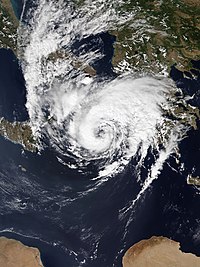
Photo from wikipedia
Abstract This study examines the atmospheric dynamics that facilitated frequent and intense dust storms over the eastern Mediterranean in March 2018 via the synergy of satellite observations, ground-based measurements and… Click to show full abstract
Abstract This study examines the atmospheric dynamics that facilitated frequent and intense dust storms over the eastern Mediterranean in March 2018 via the synergy of satellite observations, ground-based measurements and reanalysis. The negative NAO phase in March 2018 caused cold weather conditions over the central/west Europe and strengthened the temperature gradient between cold European and warm North-African air at all levels from the surface up to 300 hPa. Large negative mean sea-level pressure (MSLP) anomalies over the western Mediterranean and south Europe strengthened the sea-level pressure and geopotential-height gradients across the Mediterranean, resulting in intensification of the westerlies over the west/central Mediterranean and the development of the Sharav cyclones along the north African coast. In addition, enhanced south/southwesterlies dominated over the eastern Mediterranean, associated with cyclonic conditions and intense dust storms on several days in March 2018. These meteorological conditions resulted in an increase of ~0.3–0.4 in AOD (~100%) and ~200 μg m−3 in surface dust concentration over parts of the eastern Mediterranean, compared to the mean March climatology. The vertical aerosol profiles over the eastern Mediterranean show a large increase in the mean extinction coefficient (~200 Mm−1) due to dust loading at altitudes between ~1 and 4 km. The dust radiative impact caused a significant decrease (~−10 Wm−2) in the incoming solar radiation under clear skies and in the latent and sensible energy fluxes over the eastern Mediterranean in March 2018, thus modulating the radiation/energy budget.
Journal Title: Atmospheric Research
Year Published: 2019
Link to full text (if available)
Share on Social Media: Sign Up to like & get
recommendations!